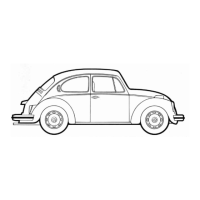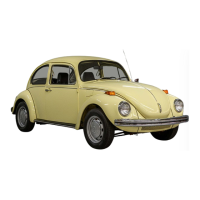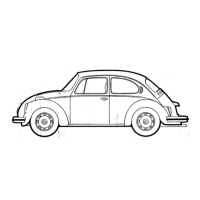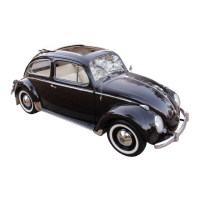Do you have a question about the Volkswagen Beetle 1978 and is the answer not in the manual?
Contains useful information for safe operation and enjoyment of your new car.
Explains how to keep your car in top condition through regular servicing.
Assures compliance with Federal Motor Vehicle Safety Standards; shows production details.
Located on the instrument panel, visible through the windshield for protection.
Stamped on the alternator support flange for identification.
Instructions on how to open and lock doors using the exterior handle and key.
Details on how to adjust the driver's seat forward, backward, and recline.
Procedure for adjusting the backrest angle for optimal support and safety.
Instructions on how to unlock and tilt the backrest for access.
Information on front seat belt operation, features, and proper usage.
Description of the audio-visual system reminding the driver to fasten belts.
Explanation of the brake warning light and troubleshooting for brake system issues.
Explanation of dashboard warning lights (EGR, CAT, etc.) and the fuel gauge.
How to use the lever for indicating lane changes on expressways.
Operation of the headlight dimmer for low and high beams.
Instructions for operating the windshield wipers at different speeds.
How to operate the windshield washer for cleaning the windshield.
Instructions for opening, removing, and reinstalling the front ashtray.
Instructions for removing and reinstalling the rear ashtray.
Description of the outside mirror's adjustability and function.
How to adjust the inside mirror for day and night visibility (Convertible only).
Proper use of the clutch pedal for gear changes and preventing wear.
Guidance on checking brake operation, pedal obstruction, and brake fluid.
Recommendations for smooth acceleration for fuel economy and reduced wear.
Recommended speed ranges for each gear for optimal performance and efficiency.
Procedure for engaging the reverse gear and its automatic back-up lights.
How to set and release the parking brake, including warning light function.
Specific advice for starting the engine in cold winter conditions.
Important information for owners of cars equipped with a catalytic converter.
Instructions for opening, closing, and locking the glove compartment.
How to unlock and open the front hood for luggage access.
Details on expanding luggage space by folding the rear seat.
Control for adjusting the interior temperature level.
Description of the footwell outlets and their heat distribution control.
Regulating fresh air volume for each side of the car.
Description of fresh air vents and how to direct airflow.
Step-by-step instructions for opening the convertible top.
Step-by-step instructions for closing the convertible top.
Overview of the switches and controls for the air conditioning system.
Function of the switch for turning the system on/off and controlling fan speed.
How to select the desired cooling range for the air conditioning.
How to adjust the air discharge louvers for optimal airflow direction.
Procedure for turning off the air conditioning system.
Tips for using the air conditioner effectively, including fogging and highway driving.
Advice on periodic operation and servicing of the air conditioner.
Location and function of the automatic resetting circuit breaker for the AC system.
Guidelines and procedures for towing the vehicle in emergency situations.
Recommendations for towing a trailer, including gear selection and braking.
Considerations for operating the vehicle during winter months, focusing on the battery.
Advice on preventing door locks from freezing and ensuring proper function.
Importance of maintaining recommended tire pressures for handling and wear.
Recommendations for rotating tires to promote longer wear and evenness.
Importance of balancing wheels after repair or periodically for handling.
Indicators of tire wear and when tires should be replaced.
Advice on using winter tires for improved traction in snow and slush.
Guidelines for using snow chains on rear wheels and restrictions.
Regular checks for tire damage, oil/gasoline exposure, and valve caps.
Information on the spare wheel's connection to the washer system and pressure.
How to check and adjust tire pressure using the spare tire's air supply.
Importance of brake fluid level and replacement schedule for safety.
Requirements for fuel type (unleaded only) and additives for cars with catalytic converters.
Diagram of the fuse box layout and identification of fuse functions.
Steps for washing the car, including recommended products and avoiding direct sunlight.
Procedure for replacing sealed beam headlight units and adjusting them.
Instructions for replacing bulbs in the front turn signal, parking, and side marker lights.
How to replace the bulb for the license plate light.
Instructions for replacing the interior light bulb.
Procedure for safely removing spark plugs from the engine.
Methods for cleaning spark plugs, avoiding wire brushes.
Proper technique for installing new or cleaned spark plugs.
How to check engine oil level using the dipstick and adding oil if needed.
Lubrication schedule and procedure for the front axle grease fittings.
Lubrication intervals and methods for door hinges and lock cylinders.
Guidance on selecting and using the correct engine oil grades based on climate.
Information on the recommended transmission oil type and its specifications.
Advice on the use and non-use of lubricant additives with fuel or oil.
Types of grease recommended for lubrication points like axles and hinges.
Troubleshooting steps for when the engine does not crank or turn over.
Diagnosing issues when the engine turns over but doesn't start.
Detailed technical specifications for the engine, including displacement and power.
Technical details regarding the transmission, clutch, and drive shafts.
Specific chassis information and dimensions for the Beetle model.
Specific chassis information and dimensions for the Convertible model.
Explanation of how the vehicle's systems reduce harmful emissions.
How the combustion system helps maintain low harmful emissions.
Details on the fuel tank and vent lines preventing fuel escape.
Function of the carbon canister in trapping fuel vapors.
Contains useful information for safe operation and enjoyment of your new car.
Explains how to keep your car in top condition through regular servicing.
Assures compliance with Federal Motor Vehicle Safety Standards; shows production details.
Located on the instrument panel, visible through the windshield for protection.
Stamped on the alternator support flange for identification.
Instructions on how to open and lock doors using the exterior handle and key.
Details on how to adjust the driver's seat forward, backward, and recline.
Procedure for adjusting the backrest angle for optimal support and safety.
Instructions on how to unlock and tilt the backrest for access.
Information on front seat belt operation, features, and proper usage.
Description of the audio-visual system reminding the driver to fasten belts.
Explanation of the brake warning light and troubleshooting for brake system issues.
Explanation of dashboard warning lights (EGR, CAT, etc.) and the fuel gauge.
How to use the lever for indicating lane changes on expressways.
Operation of the headlight dimmer for low and high beams.
Instructions for operating the windshield wipers at different speeds.
How to operate the windshield washer for cleaning the windshield.
Instructions for opening, removing, and reinstalling the front ashtray.
Instructions for removing and reinstalling the rear ashtray.
Description of the outside mirror's adjustability and function.
How to adjust the inside mirror for day and night visibility (Convertible only).
Proper use of the clutch pedal for gear changes and preventing wear.
Guidance on checking brake operation, pedal obstruction, and brake fluid.
Recommendations for smooth acceleration for fuel economy and reduced wear.
Recommended speed ranges for each gear for optimal performance and efficiency.
Procedure for engaging the reverse gear and its automatic back-up lights.
How to set and release the parking brake, including warning light function.
Specific advice for starting the engine in cold winter conditions.
Important information for owners of cars equipped with a catalytic converter.
Instructions for opening, closing, and locking the glove compartment.
How to unlock and open the front hood for luggage access.
Details on expanding luggage space by folding the rear seat.
Control for adjusting the interior temperature level.
Description of the footwell outlets and their heat distribution control.
Regulating fresh air volume for each side of the car.
Description of fresh air vents and how to direct airflow.
Step-by-step instructions for opening the convertible top.
Step-by-step instructions for closing the convertible top.
Overview of the switches and controls for the air conditioning system.
Function of the switch for turning the system on/off and controlling fan speed.
How to select the desired cooling range for the air conditioning.
How to adjust the air discharge louvers for optimal airflow direction.
Procedure for turning off the air conditioning system.
Tips for using the air conditioner effectively, including fogging and highway driving.
Advice on periodic operation and servicing of the air conditioner.
Location and function of the automatic resetting circuit breaker for the AC system.
Guidelines and procedures for towing the vehicle in emergency situations.
Recommendations for towing a trailer, including gear selection and braking.
Considerations for operating the vehicle during winter months, focusing on the battery.
Advice on preventing door locks from freezing and ensuring proper function.
Importance of maintaining recommended tire pressures for handling and wear.
Recommendations for rotating tires to promote longer wear and evenness.
Importance of balancing wheels after repair or periodically for handling.
Indicators of tire wear and when tires should be replaced.
Advice on using winter tires for improved traction in snow and slush.
Guidelines for using snow chains on rear wheels and restrictions.
Regular checks for tire damage, oil/gasoline exposure, and valve caps.
Information on the spare wheel's connection to the washer system and pressure.
How to check and adjust tire pressure using the spare tire's air supply.
Importance of brake fluid level and replacement schedule for safety.
Requirements for fuel type (unleaded only) and additives for cars with catalytic converters.
Diagram of the fuse box layout and identification of fuse functions.
Steps for washing the car, including recommended products and avoiding direct sunlight.
Procedure for replacing sealed beam headlight units and adjusting them.
Instructions for replacing bulbs in the front turn signal, parking, and side marker lights.
How to replace the bulb for the license plate light.
Instructions for replacing the interior light bulb.
Procedure for safely removing spark plugs from the engine.
Methods for cleaning spark plugs, avoiding wire brushes.
Proper technique for installing new or cleaned spark plugs.
How to check engine oil level using the dipstick and adding oil if needed.
Lubrication schedule and procedure for the front axle grease fittings.
Lubrication intervals and methods for door hinges and lock cylinders.
Guidance on selecting and using the correct engine oil grades based on climate.
Information on the recommended transmission oil type and its specifications.
Advice on the use and non-use of lubricant additives with fuel or oil.
Types of grease recommended for lubrication points like axles and hinges.
Troubleshooting steps for when the engine does not crank or turn over.
Diagnosing issues when the engine turns over but doesn't start.
Detailed technical specifications for the engine, including displacement and power.
Technical details regarding the transmission, clutch, and drive shafts.
Specific chassis information and dimensions for the Beetle model.
Specific chassis information and dimensions for the Convertible model.
Explanation of how the vehicle's systems reduce harmful emissions.
How the combustion system helps maintain low harmful emissions.
Details on the fuel tank and vent lines preventing fuel escape.
Function of the carbon canister in trapping fuel vapors.
| Brand | Volkswagen |
|---|---|
| Model | Beetle 1978 |
| Category | Automobile |
| Language | English |











